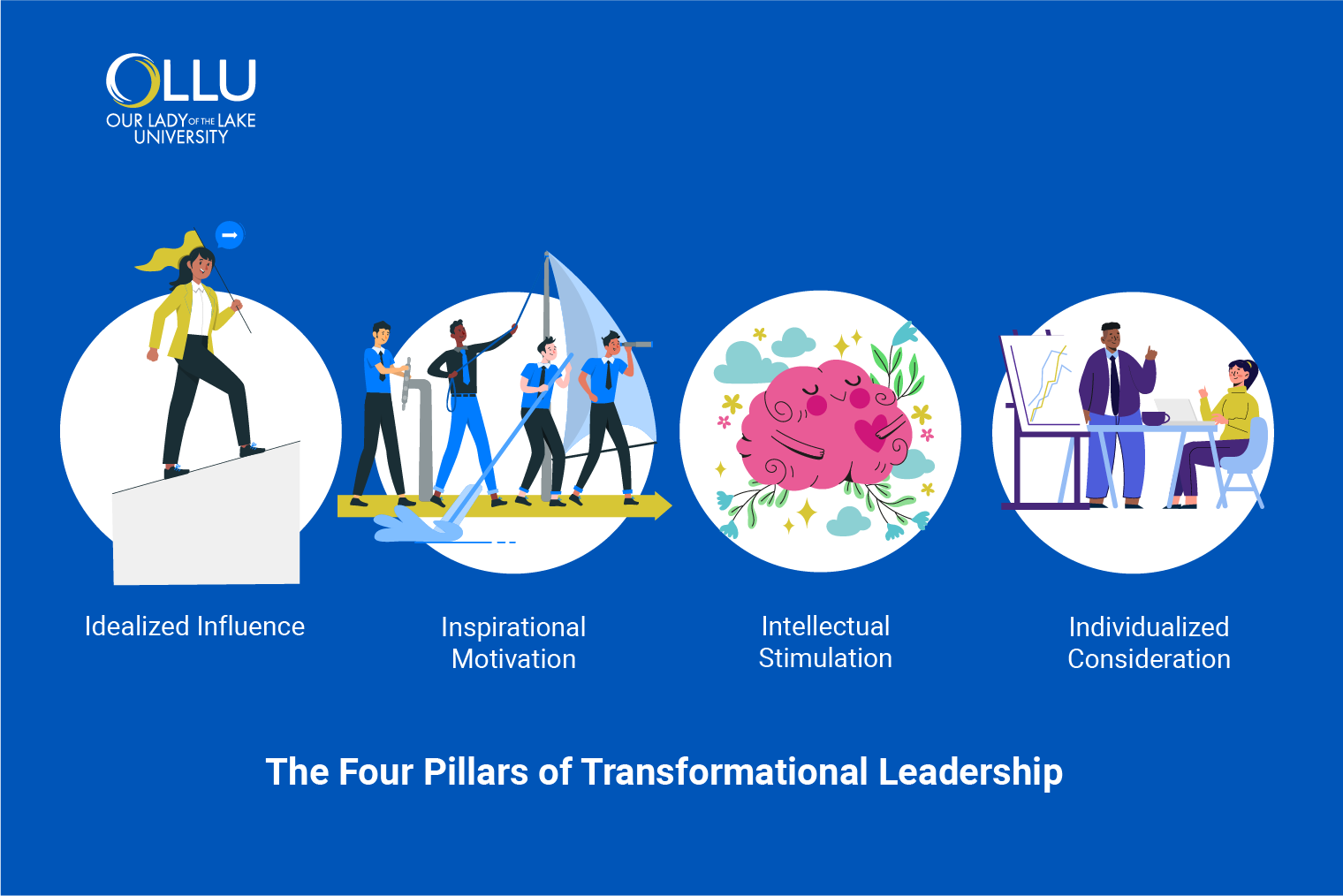What Is Transformational Leadership?
Mar 04, 2024

One widely recognized approach in the realm of leadership theories is transformational
leadership. As organizations adapt to a changing world, understanding the basics of
transformational leadership becomes crucial.
This blog dives into the main ideas behind this type of leadership, exploring its
origins, key features, and how it affects individuals and teams. We'll break down
the four main aspects of transformational leadership—idealized influence, inspirational
motivation, intellectual stimulation, and individualized consideration—each playing
a crucial role in a leader's ability to inspire positive change.
Additionally, we'll look at real-life examples to show how transformational leadership goes beyond just managing people to creating an environment where innovation, motivation, and personal growth thrive. Come along as we explore transformational leadership and see how it's become a guide for effective leadership in today's organizations.
What Is Transformational Leadership?
Transformational leadership is a leadership style that highlights inspiring and motivating team members to achieve extraordinary outcomes and develop their full potential. In organizational settings, this approach goes beyond traditional management by fostering a sense of shared vision, innovation, and personal growth among team members. Leaders employing transformational leadership are characterized by their ability to create a compelling vision, act as role models, and encourage others to transcend their self-interests for the collective benefit of the team or organization.
The significance of transformational leadership lies in its capacity to instigate positive change, enhance team cohesion, and stimulate individual and collective creativity. By emphasizing values, vision, and the well-being of followers, transformational leaders create a dynamic and engaging work environment that promotes adaptability and success in the face of organizational challenges.
What Are the Four Pillars of Transformational Leadership?

The four components of transformational leadership form the core pillars that distinguish
this leadership style. These components are essential for understanding how transformational
leaders inspire and drive positive change within organizational settings. Below, we
discuss each of these components in detail:
1. Intellectual Stimulation
Intellectual stimulation within transformational leadership revolves around motivating employees to continuously learn and develop new skills. Transformational leaders actively encourage team members to question assumptions, think critically, and explore innovative solutions. These leaders empower employees to contribute diverse perspectives to the organizational discourse by fostering an environment that values intellectual curiosity and creative problem-solving.
For instance, a transformational leader might encourage regular brainstorming sessions and cross-functional collaborations or provide learning opportunities to broaden employees' skill sets. The emphasis is on challenging the status quo and cultivating a culture that views challenges as opportunities for growth. Through such initiatives, transformational leaders not only enhance the collective knowledge base but also contribute to the overall adaptability and resilience of the organization.
2. Individual Consideration
Individual consideration is a crucial component of transformational leadership, underscoring the leader's commitment to understanding and addressing the needs of each team member. Empathy and active listening are pivotal as transformational leaders strive to create a supportive and inclusive workplace. By actively listening to employees' concerns and perspectives, leaders can tailor their approach to suit individual needs, whether it involves providing personalized mentorship, recognizing achievements, or offering solutions to challenges.
This customized attention fosters a sense of value and belonging and positively impacts employee morale and engagement. When team members feel heard and understood, they are more likely to be motivated, committed, and enthusiastic contributors to the organization's goals, thus reinforcing the transformative impact of individual consideration within the realm of leadership.
3. Inspirational Motivation
Inspirational motivation is a hallmark of transformational leadership, showcasing the leader's ability to effectively communicate and instill a shared vision within the organization. Transformational leaders articulate a compelling mission, fostering a sense of purpose among team members. Through clear and inspiring communication, leaders motivate individuals to work towards common goals, creating a shared sense of enthusiasm and commitment. This boosts immediate productivity and cultivates a workforce that feels confident and empowered.
In the long term, a motivated and confident workforce tends to exhibit higher levels of autonomy and creativity, contributing to sustained innovation and adaptability. By aligning individual aspirations with the organizational mission, inspirational motivation becomes a catalyst for a cohesive and high-performing team, ultimately driving the organization toward enduring success.
4. Idealized Influence
Idealized influence is a crucial component of transformational leadership, emphasizing the leader's role in setting challenging yet attainable expectations for themselves and their team. Leaders who embody idealized influence lead by example, demonstrating a commitment to the organization's values and goals. Consistency in actions and words is paramount in building trust and credibility. By showcasing integrity, determination, and a strong work ethic, leaders inspire their teams to emulate these qualities. This creates a positive work culture and fosters a sense of engagement and trust among team members. Through idealized influence, transformational leaders establish a foundation for a cohesive and motivated team, where shared values and a collective commitment drive individual and organizational success.
What Are the Essential Traits of Transformational Leaders?
Transformational leaders possess unique qualities that inspire and motivate their teams toward achieving extraordinary results. First and foremost, a visionary outlook is crucial, as transformational leaders articulate a compelling vision that guides the organization's direction. Secondly, empathy plays a key role, as leaders who understand and address the individual needs of their team members foster a positive and inclusive work environment.
Effective communication skills are also vital for conveying the organization's mission and motivating the workforce. Integrity and consistency are also fundamental, as transformational leaders lead by example, building trust and credibility within their teams. Finally, adaptability allows leaders to navigate changing landscapes, ensuring resilience and continued success. These traits collectively contribute to the transformative impact of leadership in organizational settings.
What Are the Benefits of Transformational Leadership?
The benefits of transformational leadership are manifold, significantly impacting both individuals and organizations:
- This leadership style fosters a sense of shared vision and purpose, aligning team members toward common goals. Transformational leaders contribute to enhanced problem-solving and adaptability within the organization by promoting a culture of innovation and creativity,
- The emphasis on individual consideration and empathy increases employee satisfaction, engagement, and a sense of value. The motivational aspects of transformational leadership lead to higher levels of performance and productivity, as team members are inspired to go above and beyond in their efforts.
- Transformational leaders' positive and inclusive work environment encourages collaboration and cohesive teamwork.
Overall, the benefits of transformational leadership extend beyond immediate outcomes, contributing to long-term organizational success and sustainability.
Transformational Leadership vs. Transactional Leadership
Managers often employ distinct leadership styles based on organizational needs, with transformational and transactional leadership as prominent approaches. While both styles aim to achieve organizational objectives, they differ in their methods and focus.
Transformational leadership
Transformational leadership's focus is inspiring and motivating individuals to achieve exceptional results and embrace long-term goals. This approach encourages innovation by fostering a culture where creativity is valued and team members are empowered to think outside the box. A practical example of transformational leadership in action could involve a leader inspiring change within a team by introducing a new project. The leader would articulate a compelling vision for the project, emphasizing its significance and aligning it with the team's values. The leader would encourage team members to share their ideas through open communication, fostering a collaborative environment. By acknowledging and incorporating diverse perspectives, the leader promotes intellectual stimulation.
Moreover, the leader would actively support and mentor team members, providing opportunities for personal growth and skill development. This transformative approach leads to successful project outcomes and instills a sense of purpose and commitment among team members, contributing to long-term success.
Transactional leadership
Transactional leadership relies on a structured, task-oriented approach, emphasizing clear guidance, rewards, and punishments to drive performance and achieve specific objectives. In a transactional leadership scenario, leaders establish well-defined roles and expectations, outlining the tasks that must be accomplished. Rewards, such as bonuses or recognition, are offered for meeting or exceeding expectations, while consequences are enforced for failing to do so.
An example of a situation where a transactional leadership style would be appropriate is in a manufacturing or production setting with clearly defined tasks and processes. In such an environment, efficiency and consistency are paramount, and transactional leaders can effectively ensure that team members adhere to established procedures, meet targets, and receive rewards for their performance. This style suits situations where routine and precision are critical for achieving organizational objectives.
The Bottom Line
Transformational leadership drives innovation, motivation, and long-term success by fostering a culture of creativity and adaptability through visionary outlook, empathy, and effective communication. Essential traits such as setting an example, building trust, and promoting continuous learning underscore the leader's role. In contrast, effective in structured contexts, transactional leadership relies on clear guidance and rewards. Influential leaders, whether employing transformational or transactional strategies, significantly influence the culture and success of their teams and organizations.
Earning an advanced degree in Leadership can help you develop the skills and knowledge to be a transformational leader. The Master of Business Administration at OLLU is designed to take your leadership to the most advanced levels and can help you motivate and inspire individuals in your organization.
Frequently Asked Questions (FAQs):
What is the difference between a leader and a transformational leader?
While leaders guide and direct, transformational leaders inspire and motivate through a shared vision, fostering innovation and personal growth.
Who is an example of a transformational leader?
Elon Musk exemplifies a transformational leader known for his visionary approach, innovation in multiple industries, and the ability to inspire teams toward ambitious goals.